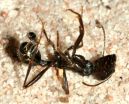(Press-News.org) In nature, it is very rare to find a proverbial much smaller David able to overpower and kill a Goliath for supper. This is exactly the modus operandi of a solitary tiny spider from the Negev desert in Israel that routinely kills ants up to almost four times its own size. Details about how it attacks and kills its prey with a venomous bite is published in Springer's journal Naturwissenschaften – The Science of Nature. The study was led by Stano Pekár of Masaryk University in the Czech Republic.
Pekár's team observed the natural prey and predatory behavior of the minute ant-eating Zodarion cyrenaicum spider in the field and in the laboratory. This spider feeds almost exclusively on the Messor arenarius ant. It can grow up to 17 millimeters and is therefore practically a giant compared to a spiderling of up to three millimetres in size. Two versions or morphs of this ant - a larger and a smaller one - are found.
Surprisingly, it was found that the spider, already at the juvenile stage, deliberately chooses to hunt Messor arenarius above all other ant species present in the sand dunes. This is in contrast to other Zodarion species where juveniles select small ants that are comparable to their own size and, as they develop, switch to larger ant species. The researchers suggest that this active selection is likely because the spider is able to recognize a specific component of a pheromone, a chemical substance, produced by the ant. Pekár's team also found that the adult female spiders generally capture the large morphs, while the tiny juvenile spiders catch smaller ants. In all cases, though, the spiders were much smaller than their prey. The giant ants were always captured by a single individual, and immobilized with a single bite.
Previous work done by Pekár showed that the capture strategy of female adult spiders includes a fast attack from behind, followed by a retreat to avoid counter-attacks by the ants. In the present study, he noted that the tiny juveniles' attack strategy differs from that of the females. Thanks to their tiny size, they are able to climb on the dorsal side of an ant and deliver an immobilizing bite to the abdomen, thus avoiding retaliation by the immediately helpless prey.
The venom glands of adult ant-eating spiders are more than 50 times larger than those of the juveniles. However, it only takes about twice as long for the venom of the younger spiders to take effect. This suggests that this spider species possesses very potent venom already at the juvenile stage. The greater success of adult spiders in capturing prey is most likely because they are able to inject more venom into their prey.
"Specialized capture combined with very effective venom enables this ant-eating spider to capture giant prey," Pekár concludes.
INFORMATION:
Reference: Pekár, S. et al (2014). David and Goliath: potent venom of an ant-eating spider (Araneae) enables capture of a giant prey, Naturwissenschaften – The Science of Nature. DOI 10.1007/s00114-014-1189-8
The full-text article and photos are available to journalists on request.
David and Goliath: How a tiny spider catches much larger prey
Minute spider needs only one bite to paralyze its prey
2014-06-12
ELSE PRESS RELEASES FROM THIS DATE:
Survivors of childhood liver transplant at risk of becoming 'skinny fat'
2014-06-12
New research reports that survivors of childhood liver transplant remain nutritionally compromised over the long-term. Findings published in Liver Transplantation, a journal of the American Association for the Study of Liver Diseases and the International Liver Transplantation Society, indicate that the recipients' return to normal weight post-transplant was due to an increase in fat mass as body cell mass remained low, indicating a slim body composition with little lean muscle mass or "skinny fat."
Children with end-stage liver disease may be malnourished due to inadequate ...
Scientists closing in on new obesity drug
2014-06-12
Obesity and diabetes are among the fastest growing health problems in the world, and the hunt is in for a pill that can fight the problem. Now a Danish/British team has come up with a smart tool that will speed up the scientific hunting process, and we may be one step closer to a pill against obesity.
The body has a variety of functions that decide if we get overweight or not. For instance hormones control our appetite and the uptake of food. In recent years science has taken on the quest of investigating these physiological functions and finding a medical way to fight ...
Children showing signs of social withdrawal in risk of internalized distress
2014-06-12
Children are showing signs of social withdrawal are more susceptible to parental influences than others. These children were also more prone to distress caused by the impacts of guilt-inducing parenting.
The researchers of the University of Jyväskylä, Finland, have found that children showing signs of social withdrawal are more susceptible to parental influences than others. The researchers followed up about 300 children across the first three years of primary school and monitored the children's social skills and problem behaviors. At the same time, mothers' and fathers' ...
Recreational football can treat hypertensive and type 2 diabetes patients
2014-06-12
The studies, published in the acclaimed Scandinavian Journal of Medicine & Science in Sports, show that 24 weeks of twice-weekly recreational football training sessions lower blood pressure and improves heart function in men with high blood pressure and men with type 2 diabetes. Furthermore, men with type 2 diabetes lost 12 % of their abdominal fat and reduced their blood sugar 20% more than inactive control subjects.
These effects are likely to reduce the risk of developing heart diseases including heart failure and myocardial infarction, and the participants had a reduced ...
Does food addiction exist?
2014-06-12
Women with weight problems were more impulsive than average in a food-related psychology test, a new research paper has shown. This suggested that they are more instinctively stimulated by images of food as well as lacking contemplative will power. Further, some women reported food craving even if they had eaten recently, a symptom of possible food addiction.
"All addictions are similar in that the sufferer craves to excess the feel-good buzz they receive from chemical neurotransmitters produced when they eat, gamble, smoke, have sex or take drugs," commented Claus Voegele, ...
Blood product sterilization taken too far?
2014-06-12
Certain processes used to sterilize blood products could potentially cause serious health issues in transfusion recipients, according to an international study published in the journal Platelets and led by Dr. Patrick Provost of Université Laval's Faculty of Medicine and the CHU de Québec Research Center. These processes purportedly alter the blood platelets to the extent of preventing them from carrying out their functions correctly and may be the cause of hemorrhages observed in patients having received treated blood.
The function of platelets goes far beyond their ...
When good people do bad things
2014-06-12
CAMBRIDGE, MA -- When people get together in groups, unusual things can happen — both good and bad. Groups create important social institutions that an individual could not achieve alone, but there can be a darker side to such alliances: Belonging to a group makes people more likely to harm others outside the group.
"Although humans exhibit strong preferences for equity and moral prohibitions against harm in many contexts, people's priorities change when there is an 'us' and a 'them,'" says Rebecca Saxe, an associate professor of cognitive neuroscience at MIT. "A group ...
Study of white sharks in the northwest Atlantic offers optimistic outlook for recovery
2014-06-12
White sharks are among the largest, most widespread apex predators in the ocean, but are also among the most vulnerable. A new study, the most comprehensive ever on seasonal distribution patterns and historic trends in abundance of white sharks (Carcharodon carcharias) in the western North Atlantic Ocean, used records compiled over more than 200 years to update knowledge and fill in gaps in information about this species.
Scientists from NOAA Fisheries and colleagues added recent unpublished records to previously published data to present a broad picture of 649 confirmed ...
Antibodies from the desert as guides to diseased cells
2014-06-12
The use of nanoparticles in cancer research is considered as a promising approach in detecting and fighting tumour cells. The method has, however, often failed because the human immune system recognizes the particles as foreign objects and rejects them before they can fulfil their function. Researchers at the Helmholtz-Zentrum Dresden-Rossendorf (HZDR) and at University College Dublin in Ireland have, along with other partners, developed nanoparticles that not only bypass the body's defence system, but also find their way to the diseased cells. This procedure uses fragments ...
Proliferation cues 'natural killer' cells for job change
2014-06-12
PROVIDENCE, R.I. [Brown University] —The immune system maintains a rich abundance of "natural killer" cells to confront microbial invaders, but as the body gains the upper hand in various infections it sometimes starts to produce even more of the cells. For three decades, scientists haven't understood what purpose that serves. In a new paper, Brown University researchers show one: proliferation helps change the NK cells' function from stimulating the immune response to calming it down, lest it get out of hand.
In a series of experiments now published online in the Journal ...
LAST 30 PRESS RELEASES:
Numbers in our sights affect how we perceive space
SIMJ announces global collaborative book project in commemoration of its 75th anniversary
Air pollution exposure and birth weight
Obstructive sleep apnea risk and mental health conditions among older adults
How talking slows eye movements behind the wheel
The Ceramic Society of Japan’s Oxoate Ceramics Research Association launches new international book project
Heart-brain connection: international study reveals the role of the vagus nerve in keeping the heart young
Researchers identify Rb1 as a predictive biomarker for a new therapeutic strategy in some breast cancers
Survey reveals ethical gaps slowing AI adoption in pediatric surgery
Stimulant ADHD medications work differently than thought
AI overestimates how smart people are, according to HSE economists
HSE researchers create genome-wide map of quadruplexes
Scientists boost cell "powerhouses" to burn more calories
Automatic label checking: The missing step in making reliable medical AI
Low daily alcohol intake linked to 50% heightened mouth cancer risk in India
American Meteorological Society announces Rick Spinrad as 2026 President-Elect
Biomass-based carbon capture spotlighted in newly released global climate webinar recording
Illuminating invisible nano pollutants: advanced bioimaging tracks the full journey of emerging nanoscale contaminants in living systems
How does age affect recovery from spinal cord injury?
Novel AI tool offers prognosis for patients with head and neck cancer
Fathers’ microplastic exposure tied to their children’s metabolic problems
Research validates laboratory model for studying high-grade serous ovarian cancer
SIR 2026 delivers transformative breakthroughs in minimally invasive medicine to improve patient care
Stem Cell Reports most downloaded papers of 2025 highlight the breadth and impact of stem cell research
Oxford-led study estimates NHS spends around 3% of its primary and secondary care budget on the health impacts of heat and cold in England
A researcher’s long quest leads to a smart composite breakthrough
Urban wild bees act as “microbial sensors” of city health.
New study finds where you live affects recovery after a hip fracture
Forecasting the impact of fully automated vehicle adoption on US road traffic injuries
Alcohol-related hospitalizations from 2016 to 2022
[Press-News.org] David and Goliath: How a tiny spider catches much larger preyMinute spider needs only one bite to paralyze its prey


